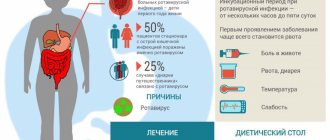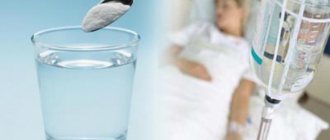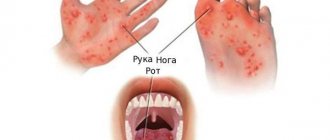Infectious disease specialist
Sinitsyn
Olga Valentinovna
34 years of experience
Highest qualification category of infectious disease doctor
Make an appointment
Rotavirus infection is a disease of viral origin that has an oral-fecal transmission mechanism. The peculiarity of the pathology is a combination of symptoms of damage to the digestive system with respiratory signs at the acute stage of the disease. The disease can be diagnosed in patients of any age, but more often in children under 2 years of age, in whom rotavirus accounts for up to 50% of all reported cases of intestinal infections.
What is rotavirus infection?
Translated from Latin, “rota” means “wheel”. Viruses received this name because they have a dense two-layer shell with a clear edge, which gives them the appearance of a wheel.
There are several types of rotaviruses that are similar in structure, so they are combined into one group.
Rotaviruses cause the development of acute intestinal infections. According to statistics, these viruses cause gastroenteritis (damage to the stomach and small intestine) in 25% of children under one year of age, in 60% - from 1 year to 3 years, in 40% - from 4 to 5-6 years.
Photo: www.pexels.com
The susceptibility of children under five to six years of age to rotaviruses is due to two factors:
- Reduced acidity of the stomach - a natural barrier to the penetration of bacteria, viruses and parasites into the gastrointestinal tract.
- Immaturity of the immune system in children of this age group.
Moreover, children under five or six years old often get this infection more than once. Moreover, the risk of a child getting sick is many times higher if he attends a kindergarten. Since there is contact with a larger number of children, among whom there may be a sick baby.
While older children and adults suffer from this disease much less frequently. Because a mature immune system gives a worthy rebuff to “strangers”. In addition, children who have been ill previously already have their own antibodies against certain types of rotaviruses, which protect them from infection.
Breastfed children are relatively protected from rotavirus infection. Because breast milk produces antibodies (immune system proteins) that prevent viruses from entering the body. However, babies are very inquisitive, and when getting acquainted with the world around them, they crawl and “test” objects. Therefore, their risk of encountering the virus is quite high.
First aid for a child with rotavirus infection
28.09.2021
The group of viral infections that most often cause intestinal flu is called rotavirus. It can occur in both adults and children. However, in adults it occurs in a mild form. In children, the disease occurs in a more complex form, which can subsequently cause complications for the development of the child’s body. Therefore, it is important to notice the symptoms already at the initial stage of the disease.
Signs of rotavirus in children. There are several stages during this disease:
1. The incubation period lasts up to five days; 2. The acute period ranges from three to seven days; 3. The period of recovery of the body is from four days;
The onset of the disease manifests itself in the child's slight malaise, lethargy, fatigue, drowsiness, and lack of desire to play or run. The baby's musculoskeletal system will be slow. There is an increase in body temperature, accompanied by vomiting and pain in the abdominal . Diarrhea may develop . It is important to pay attention to the baby's stool. On the first day of infection it will be liquid and yellow in color. In the next days the consistency will become like gray clay. In addition, the child may show signs of ARVI ( runny nose , sore throat , cough).
How does infection occur?
Rotavirus is an infectious and contagious disease. It is transmitted:
- through food products that contain rotavirus; — by contact, for example, through unwashed and dirty hands;
- also by airborne droplets (when coughing and sneezing), the disease is seasonal, with a special peak of spread recorded from November to April.
The virus, penetrating the body, first of all destroys those cells located in the small intestine . Therefore, dehydration occurs and drinking water is necessary. In addition, due to this, the breakdown of complex carbohydrates (protein, lactose) is disrupted.
First aid for a child.
- Of course, at the first sign of rotavirus, you should definitely call a doctor at home. Avoid contact between the child and other people to avoid further spread of this infection.
- Before the doctor , you should not give your baby painkillers . Reduced pain will mask the symptoms of more serious diseases. Also, if your appetite is reduced, you should not force your child to eat . You can drink jelly and chicken broth. Large volumes of water can cause vomiting. Therefore, the baby should be given drinks in small portions every half hour, monitoring the condition.
- At the first symptoms, exclude carbonated drinks, sweets, and fruits. It is forbidden to consume dairy products, as they, due to their environment, can provoke further growth of bacteria. If a small child is breastfed, then pediatricians allow continued feeding during illness. You can eat soups with low-fat broth, berry infusions, rice, buckwheat, and fish. Fried and fatty foods, pasta and smoked foods are not allowed. A light diet is followed both during illness and during the recovery period.
- In addition, before being examined by a pediatrician you should not give your baby antiviral drugs, anti-vomiting powders, tablets, or syrups for loose stools.
- If a child’s temperature to 38 degrees, there is no need to bring it down suddenly. Rotavirus dies at this temperature. If it does not subside within a day, then it is better to light candles or rub the body.
- If we talk about preventive measures, then they only include vaccination . There are no other ways to protect against rotavirus. But this does not exclude the observance of personal hygiene and compliance with food processing rules.
Thus, rotavirus infection is a dangerous disease for a child. There is no special treatment or medicine. Like any virus, it will pass. The main thing during the period of illness is to follow all the doctor’s .
Published in Pediatrics Premium Clinic
Rotavirus infection - “disease of dirty hands” or “intestinal flu”?
In fact, both names fully characterize the disease. Since viruses are mainly transmitted through unwashed children's hands, contaminated toys, food or water.
Once in the body, viruses rush into the small intestine, causing damage and rejection of its villi.
As a result, immature cells of the small intestine appear that do not produce enough digestive enzymes. Therefore, the digestion and absorption of nutrients is impaired. Thus, a cascade of complex processes is launched, leading to the release of water and salts into the intestinal lumen, which is manifested by loose stools and dehydration.
The source of rotavirus infection is a sick or clinically healthy carrier (without signs of disease). Isolation of the virus in feces begins on the second day of illness and then continues for two months even after all symptoms of the disease have disappeared.
Causes
The causative agent of rotavirus infection in children and adults is rotavirus, which has the ability to survive even when treated with potent disinfectant solutions. In the feces of a sick person, its vital activity persists for 7 months, in environmental conditions - for more than a month. The infection is transmitted from a carrier or a sick person through the fecal-oral route through water, food and household items, especially when the sanitary and hygienic condition of the premises is unsatisfactory.
Patients at risk for rotavirus include:
- childhood;
- with disturbances in the functioning of the immune system, when it is suppressed;
- with chronic intestinal diseases;
- with violations in the diet, as well as when changing baby food;
- working or visiting large groups;
- not observing the rules of personal hygiene.
What is the danger of rotavirus infection for children?
In a short time, intoxication and rapid dehydration of the child’s body develop, which leads to a rather severe course of the disease. Therefore, the baby runs the risk of receiving not entirely pleasant procedures in the form of injections and intravenous drips.
The maximum incidence of rotaviruses occurs in winter and spring. However, it also occurs during the rest of the year, when it would seem that the “season” has come for other intestinal infections - for example, salmonellosis or dysentery.
Moreover, it is important to distinguish a bacterial infectious disease from a rotavirus infection. Because antibiotics must be used to fight bacteria. Whereas their use for viral infections is not only inappropriate, but also harmful, weakening the functioning of the baby’s already immature immune system.
Photo: www.pexels.com
How to recognize rotavirus infection?
- The incubation period for this disease is from one to two days - the time from the moment of infection until the appearance of the first signs of the disease.
- Sometimes the disease begins gradually with the development of the prodrome period - when the disease does not manifest itself with typical symptoms, but the baby has signs of slight malaise.
“At the same time, infants become capricious, refuse to eat, and develop a slight runny nose and cough. Older children complain of fatigue, poor appetite, rumbling and discomfort in the stomach, headache, chills, nasal congestion, sore throat, and slight cough. Only after 12-72 hours do typical signs of rotavirus infection develop.
Symptoms
The disease has a cyclical development: the incubation period lasts up to 5 days, the acute period lasts 7 days, recovery occurs after another 3-5 days. The main signs of rotavirus infection include:
- sudden onset of symptoms of poisoning simultaneously with symptoms of intestinal infection;
- profuse vomiting and nausea that disappear within 24 hours from the onset of the disease;
- diarrhea with pain in the middle and upper abdomen, with the release of watery and foamy stool of a yellow-green hue;
- rumbling and transfusion in the abdomen;
- signs of general intoxication - headache, fever, feeling of weakness;
- characteristic respiratory symptoms - runny nose, swelling and redness of the throat;
- signs of dehydration caused by diarrhea and excessive vomiting.
Are you experiencing symptoms of rotavirus infection?
Only a doctor can accurately diagnose the disease. Don't delay your consultation - call
The most common course of rotavirus infection in children
The disease begins acutely with a steady increase in body temperature to 38-39°C. Moreover, it is difficult to respond to antipyretic drugs. However, sometimes older children may experience severe chills at normal or subfebrile body temperature (37-38°C).
In addition, the baby develops symptoms of intoxication: severe weakness and lethargy, dizziness. In severe cases, fainting may occur. The child also has nasal congestion, runny nose and dry cough, headache, sore throat and stomach pain.
It would seem that such manifestations are characteristic of ARVI or a cold. However, along with symptoms indicating damage to the respiratory tract, the baby experiences vomiting and diarrhea . Moreover, loose stool with rotavirus infection has its own characteristics: it is copious, watery and foamy, yellow or yellow-green in color, and does not contain impurities (mucus, streaks of blood). In mild cases of the disease, the stool is mushy.
The child’s appetite also decreases, loud rumbling and pain appear in the upper abdomen, or the pain spreads throughout the entire abdomen.
Due to vomiting and loose stools, the child develops dehydration, the symptoms of which depend on the degree of fluid loss from the body:
- With moderate dehydration, the child develops thirst, dry mouth, and pale skin.
- With severe dehydration, the baby's condition is serious. These symptoms include hoarseness, the skin becomes dry, the amount of urine produced decreases, and convulsions may occur.
However, not all children develop a severe disease. In many ways, the severity of symptoms depends on the number of rotaviruses that have entered the body.
Rotavirus intestinal infection: Symptoms and treatment in children
Rotavirus infection (rotavirus gastroenteritis or rotavirosis) is an acute intestinal infection caused by a virus of the Rotavirus genus.
The causative agent of this disease was first discovered relatively recently - in 1973. In countries where the level of medical development leaves much to be desired, rotavirus intestinal infection is one of the causes of high child mortality.
Almost all children have been infected with rotavirus at least once. It should be noted that the likelihood of re-infection is low, since after an illness a fairly strong immunity is developed. This infection is most dangerous for children aged from six months to 2-3 years.
In more than 95% of cases, sudden watery diarrhea in children is caused by rotavirus infection.
The pathogen is stable in the external environment, but quickly dies when boiled. In the human body, rotavirus dies at temperatures of 38˚ C and above.
ROUTES OF INFECTION BY ROTAVIRUS
“Intestinal flu” in children refers to the so-called “diseases of dirty hands.” The pathogen is transmitted from a sick person or a clinically healthy carrier through contact and household contact, as well as through contaminated food products (i.e., by the fecal-oral route). Even perfect adherence to hygiene rules and completely normal social and living conditions have virtually no effect on the overall level of morbidity among children.
Once in the body, rotavirus actively multiplies in the cells of the mucous membranes of the gastrointestinal tract (stomach, as well as small and large intestines). Damage to the mucous membrane is manifested by its inflammation (gastroenteritis), as a result of which the digestion process is disrupted. The pathogen is excreted in the stool, starting from the very first days after the onset of the disease.
Please note: due to its high contagiousness, rotavirus often causes outbreaks of the disease in preschool institutions.
SYMPTOMS OF ROTAVIRUS INFECTION
The duration of the incubation period can be from 1 to 5 days. Rotavirosis is characterized by an acute onset and, as a rule, a benign course. The first signs of rotavirus infection in children are:
- acute cramping pain in the abdominal area;
- vomiting (up to 3-4 times a day, including even in the morning on an empty stomach);
- decreased appetite;
- general deterioration and weakness;
- increase in general body temperature (up to 39˚ C).
Soon the patient develops acute diarrhea. Yellowish, watery stool, profuse, without blood, with a sharp sour odor. As a result of severe diarrhea, acute dehydration (dehydration) of the body develops, which can pose a threat to the patient’s life.
Signs of critical dehydration due to rotavirus infection include confusion or loss of consciousness, as well as seizures.
Other clinical manifestations that may be identified during examination include:
- redness of the ocular conjunctiva;
- hyperemia of the palatine arches and pharynx.
On the second day, as a rule, drowsiness occurs due to a general weakening of the body.
Clinical symptoms are observed for 4-7 days, after which the bright signs of rotavirus infection subside, and complete recovery occurs with the formation of a fairly stable immunity to the virus.
Mild symptoms (one-time diarrhea, slight and short-term increase in temperature) are typical for adult patients. In this case, rotavirus does not pose a particular threat, but a person, even with minor clinical manifestations, is a dangerous virus carrier for others.
TREATMENT OF ROTAVIRUS INFECTION
When the first symptoms appear, call a doctor immediately. Self-medication is dangerous.
There are no antiviral drugs that selectively act on the pathogen.
Symptomatic treatment is indicated for patients with rotavirus gastroenteritis. First of all, they need rehydration - the elimination of dehydration that develops as a result of diarrhea and vomiting. To combat dehydration and to normalize the water-electrolyte balance, it is recommended to prepare a solution of the drug Regidron for the child. The contents of 1 sachet are diluted in 1 liter of water. The baby needs to give this solution 50 ml at intervals of 1 hour. You should not drink the drug in large quantities, as vomiting may develop, and the effect will be completely opposite.
Please note: if you don’t have ready-made medications on hand, you can prepare a rehydration solution yourself. For a liter of boiled water, you need to take 1 teaspoon of baking soda (sodium bicarbonate) and table salt (sodium chloride), as well as 2-4 tablespoons of sugar. The liquid should be given to the child until normal diuresis is restored (at least once every 3 hours).
Children with rotavirus infection benefit from a gentle diet. When the first symptoms appear, milk and dairy products should be excluded from the diet, since the body does not digest lactose well due to rotavirosis. Of course, this recommendation does not apply to infants. For 2-3 weeks, it is recommended to give the baby breastfeeding 1-2 times a day, and for the rest of the feedings - soy or lactose-free formula.
A child in the acute phase, as a rule, has a complete lack of appetite, and you should not try to feed him against his will. In the first days of the disease, liquid porridge (only with water), medium-rich chicken broth and homemade jelly are recommended.
If the diagnosis of rotavirosis is confirmed, then to relieve cramping abdominal pain, the child should be given the antispasmodic drotaverine orally.
For hyperthermia, a child over one and a half years old is prescribed Paracetamol tablets. To bring down the temperature, you can also use rectal suppositories (suppositories) Cefekon. If necessary, they are placed at intervals of 2 hours.
Please note : because the pathogen dies at t = 38˚С, then it is advisable to reduce the child’s temperature only if it has risen to 39˚С or higher.
To combat intestinal upset when treating rotavirus infection, it is recommended to use Creon or Smecta.
Inflammation of the intestinal mucosa and severe diarrhea inevitably lead to dysbiosis, which negatively affects the processes of digestion and absorption of nutrients. To restore normal microbiocenosis, probiotics (bioflor, enterogermine) are indicated. It is given to children 1 capsule 2 times a day an hour before meals, dissolving the probiotic in water.
Against the background of rotavirus gastroenteritis, a secondary bacterial infection can develop.
If the child is constantly sleepy (and this is very typical for rotavirosis from the 2nd day from the onset of the disease), let him sleep as much as he needs. At the same time, do not forget to regularly measure your temperature and drink frequently, but in small volumes.
ROTAVIRUS INFECTION IN INFANTS
In infants, dehydration develops rapidly. The smaller the baby's weight, the higher the danger. Dehydration can lead to loss of consciousness and even death.
Criteria for dangerous dehydration in infants are:
- lack of sweat;
- impaired diuresis (no urination for 3 hours);
- dry tongue;
- crying without tears.
Important: remember that a sick baby may refuse a bottle of water, so this method of replenishing the lack of fluid in the body is ineffective. An infant should immediately call an ambulance! Doctors will immediately begin intravenous rehydration and, if necessary, transport the baby and mother to the hospital.
To prevent infection of other people and the subsequent spread of rotavirus infection, the patient must be isolated until convalescence (clinical recovery) occurs. All those caring for a sick child need to adhere to basic rules of personal hygiene, i.e. wash their hands with hot water and soap as often as possible.
TESTS FOR ROTAVIRUS
A stool test for rotavirus is taken (performed for a fee at the Stolbtsovsk Central District Hospital). To identify it, an antigen test is performed.
The diagnosis of rotavirus infection is considered confirmed if the pathogen is detected in the patient’s stool.
Important: the material for analysis must be delivered to the laboratory within 24 hours after receipt.
Based on the test results, a conclusion is given about the presence or absence of antigen to rotavirus in the patient’s stool. Normally, the result should only be negative.
When to see a doctor?
So, you have noticed your child has a runny nose, cough and loose stools. What to do? Perhaps there is no need to tempt fate by believing that this is just a mild intestinal upset due to the fact that the baby ate a little more fruit the day before or had a slight cold.
Therefore, if the child’s condition allows, go to see a doctor. Whereas if your baby has a high body temperature, frequent diarrhea and vomiting, call an ambulance immediately.
Principles of treatment of rotavirus infection
1. Lost fluid is replenished
In case of moderate dehydration, the child is “hydrated” using solutions used orally.
In case of severe dehydration, fluid is administered intravenously in a hospital setting. Also, if the child is able to drink and is conscious, then he is simultaneously continued to be given oral solutions.
How to “desolder”?
It is better to use ready-made pharmaceutical preparations (for example, Regidron, Reosolan or Gidrovit) in powders for dissolution. Because they have an optimal ratio of salts and dextrose.
You can also make a sugar-salt solution at home. To do this, add one teaspoon of salt, half a teaspoon of soda and 8 teaspoons of granulated sugar to one liter of boiled warm water. Then mix everything thoroughly, cool to room temperature and “drink” the baby.
It is necessary to give the baby 1-2 teaspoons of liquid every 5-10 minutes. If you exceed the volume and frequency, you can provoke vomiting, which will lead to even greater loss of fluid from the body.
Moreover, the earlier “wetting” is started, the more favorable the outcome of the disease. Therefore, as soon as the first signs of the disease appear, offer your baby something to drink before going to the doctor.
2. Enzyme preparations are prescribed because the production and activity of digestive enzymes is impaired: Pancreatin, Creon and others.
3. It is advisable to adhere to a diet so as not to increase the fermentation processes in the intestines. To do this, it is recommended to refrain from feeding the child milk and fermented milk products, exclude fruits, and also limit foods rich in easily digestible carbohydrates (sweets, pasta made from first-grade flour, and others).
4 . Due to the fact that rotavirus infection disrupts the intestinal microflora, it is advisable to use bacterial biological preparations containing lactobacilli: Lactobacterin, Acylact and others.
5. An immunoglobulin complex preparation (ICP) for oral use , containing antibodies (proteins) against rotaviruses, salmonella, Escherichia and some other pathogens of intestinal infections, has proven itself well Moreover, its use significantly reduces the duration of diarrhea, and also reduces the signs of intoxication. Therefore, recovery occurs many times faster.
6. To accelerate the removal of viruses and toxins from the body, enterosorbents are used: Lactofiltrum, Enterosgel and others.
7. Body temperature is lowered using medications containing paracetamol or ibuprofen. They are used in the form of suppositories (if stool allows, this manipulation may cause it to become more frequent) or syrup (if vomiting is rare). In case of excessive vomiting and diarrhea, an antipyretic mixture is injected intramuscularly.
Grodno Regional Children's Clinical Hospital
Details Published September 22, 2021
Rotavirus infection in children
According to WHO, every person (regardless of immunity status, gender and race) has had rotavirus infection. And those who have just been born will still have to get sick from rotavirus.
What is rotavirus infection, why is it dangerous and how to identify it? We will try to answer these and other questions in our article.
So, rotavirus infection is one of the acute intestinal infections caused by pathogens from the rotavirus family. Sometimes people call this disease “intestinal flu,” which is fundamentally wrong, since influenza viruses can exist and multiply only on the mucous membranes of the respiratory tract. But rotavirus “lives” in the small intestine and has nothing to do with damage to the respiratory tract.
Most often, this infection occurs in childhood and during the cold season. The virus is transmitted by contact - fecal-oral. You can become infected from a sick person through toys, dishes, door handles, household items, through water and food. The virus is very contagious!!!
After illness, a strong immunity to rotavirus is developed, but, unfortunately, it has almost no significance, since this virus has many varieties. Those. a person can become infected again.
After infection, the virus “lives” and multiplies in the human body asymptomatically for 3-7 days (incubation period). The disease itself takes about 2-3 days, sometimes up to 7—the acute period. The recovery period continues for at least another 5 days after the symptoms disappear.
A child is contagious ALL THE TIME from the moment of infection until the end of the recovery period!!!
The likelihood of infection does not depend in any way on the cleanliness of the child’s family. Children aged 6 months to 2 years are most often affected. In general, children from birth to 5 years of age are at risk.
The main symptoms of rotavirus infection are:
– watery diarrhea (diarrhea) without signs of blood;
- vomit;
– a sharp increase in temperature to high numbers (39 and above);
– pain in the abdomen;
- lack of appetite;
- loss of strength, weakness.
Diarrhea is the main symptom of rotavirus infection. As a rule, it lasts no more than 2 days, but is dangerous due to dehydration.
Dehydration is always a risk of damage to the nervous system, especially in children under 2 years of age. Body temperature may rise sharply, causing convulsions and then respiratory arrest. In addition, a lack of fluid in the body impairs the functioning of the lungs, which can lead to inflammation.
A typical picture: a child with dehydration ends up in the hospital, and 2 days later pneumonia is also discovered. His parents think that he became infected in the hospital, but in fact, lung problems are a common complication of any intestinal infection.
How can parents determine whether diarrhea is caused by a viral infection or food poisoning?
Food poisoning is caused by bacteria and diarrhea most often has a pasty consistency. Diarrhea with water, sour smell of feces - viral diarrhea.
The main thing that parents must learn to do is to quickly assess whether the child has signs of dehydration, since it is dehydration that poses a danger to life and health.
In all cases of diarrhea and/or vomiting in a small child, you should consult a doctor!
What symptoms should parents be alert to regarding dehydration?
If a baby's tongue becomes dry, he begins to cry without tears, does not urinate for more than 6 hours and practically does not sweat - this is a good reason to call an ambulance.
If the baby begins to lose consciousness, the eyes are “sunken,” the facial features are “sharpened,” and the body temperature is high—the help of doctors is required immediately.
If a child begins to become dehydrated and cannot or does not want to drink, then it is necessary to introduce fluid into the body intravenously. This is what inpatient treatment is based on.
If there are no signs of dehydration, then parents can easily cope with rotavirus infection at home.
So, what do you need and can do yourself?
The main principle of treating rotavirus infection is to prevent dehydration. To do this, the child must drink and drink a lot. The more often the better. You can drink in small portions, if it is difficult to drink in sips, from a teaspoon, from a syringe without a needle, but often.
The drink should be at room temperature, neither cold nor hot.
For drinking, it is better to use a saline solution, which is sold in a pharmacy, for example “Regidron” or similar ones. You can alternate the saline solution with regular boiled water. If your child urinates every 3 hours, it means he is consuming enough fluid.
If you can’t get something to drink even from a syringe or the child doesn’t drink enough, be sure to call an ambulance!
If, in addition to diarrhea, the child has vomiting, then the baby should be placed on his side so that he does not choke on the vomit.
Give antipyretics at a temperature of 38.5 and above (if there are no other indications).
Do not feed, especially by force! If your child asks to eat, you can give him some liquid porridge with WATER!
The diet should be followed not only during the acute phase of the disease, but also during the recovery process. Whole milk and dairy products, sweet fruits, baked goods, sweets, meat, fatty and fried foods are completely excluded from the diet. YOU CAN: water porridge, vegetable soups, white bread croutons, oven-baked apples. Feed frequently, but in small portions.
Very young children are not given a diet, breast milk is not limited, but they make sure that they drink plenty of fluids. Sometimes, due to an enzyme deficiency, infants may develop intolerance or partial intolerance to breast milk. In this case, reduce the frequency of breastfeeding and temporarily add lactose-free infant formula (until the child recovers completely).
You cannot take antibiotics on your own, since the disease is viral in nature, and antibiotics do not work on viruses.
As for antiviral drugs, unfortunately, at the moment there are no antiviral drugs with proven effectiveness against rotavirus.
Do not take antidiarrheal drugs! During rotavirus infection, microparticles of the virus are released in the stool. Therefore, stopping diarrhea means prolonging the disease, since virus particles will remain in the small intestine and continue to destroy beneficial cells.
Bed rest is not necessary if the child feels well enough. After the symptoms disappear, you can go for a walk, but avoid public places and contact with other children (playgrounds, playrooms, etc.).
A child can be sent to a kindergarten or school only after a recovery period, i.e. 5-7 days after the cessation of diarrhea and vomiting.
Doctor - pediatric neurologist KFD Glybokaya O.L.
Prevention is everything!
There is a misconception that if rotaviruses are transmitted through contaminated objects, then it is enough to observe the rules of personal hygiene to defeat them. This is partly true, but in the case of young children the rule does not work. Because the virus is highly contagious, it is also less affected by common hand sanitizers and soaps. Only solutions of alcohol, iodine and chlorine are effective against rotaviruses.
It is also generally accepted that it is enough to get sick once to acquire immunity for life. This idea is not entirely correct, since there are several types of rotaviruses. Therefore, there is a risk that each time the body encounters a different type of virus from the same group.
Today, a vaccine against rotaviruses has been developed - the live Rotatek vaccine for oral administration. It protects against the five most common types of rotaviruses in Russia. Immunity after vaccination lasts about five years.
Rotavirus and other intestinal infections: how to distinguish?
Children are often susceptible to infection with salmonella and dysentery bacillus.
For dysentery
The disease begins acutely with an increase in body temperature. Then liquid, mushy stool appears. Its frequency is about 10 times a day, but may be more often depending on the severity of the disease.
However, soon its volume decreases, it becomes scanty, a large amount of mucus appears in it, followed by streaks of blood. It is noteworthy that during the act of defecation (passing stool), nagging pain (tenesmus) occurs in the rectal area, sometimes quite pronounced.








